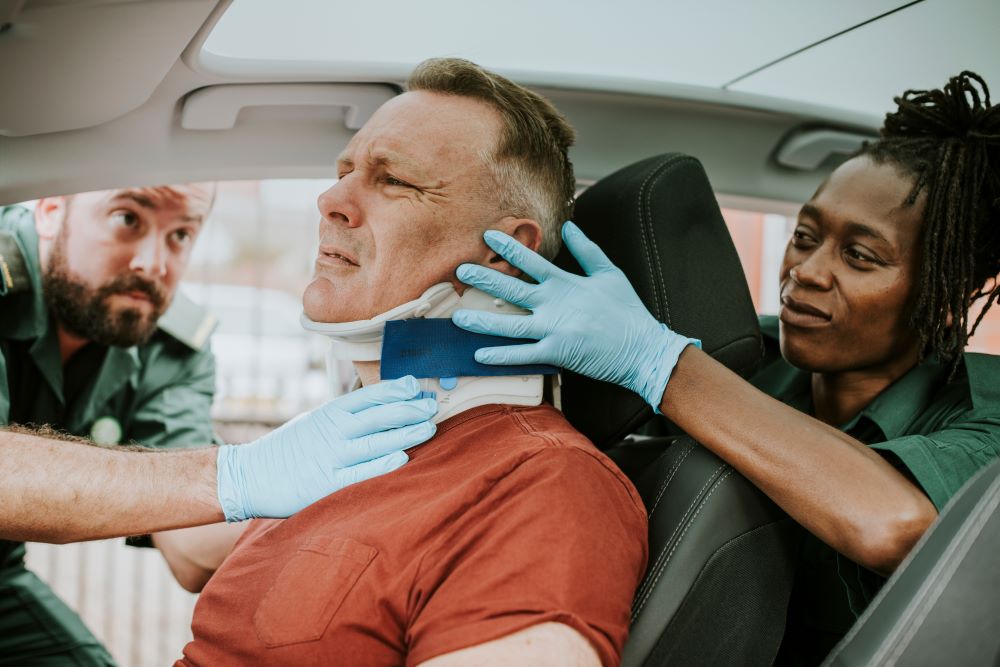Many of us get behind the wheel of our car without thinking twice about it. However, we should. The most recent report published by the North Carolina Division of Motor Vehicles, its North Carolina 2021 Traffic Crash Facts report, highlights how our state saw 276,026 auto accidents that year. Of those, 74,639 resulted in injuries and 1,653 in fatalities. What this data tells one is that our state’s roadways are certainly no place to go for a leisurely ride, but instead where, we need to be vigilant to minimize our risk of getting hurt.
Many of us do our part to drive safely and still find ourselves involved in crashes. An unfortunate consequence of this is that we end up with injuries, sometimes minor but often quite serious, to the point that their occurrence might forever change the course of our lives. Below, we call attention to injuries that often result from car accidents and wrap up this article with a discussion of what your rights are if someone else hurt you in a crash.
Common Injuries Associated With Automobile Collisions
As you might imagine, you can suffer virtually any type of injury in a wreck while riding in your car, but some occur more often than others, including:
- Head and neck injuries along with traumatic brain injuries (TBIs): Whiplash, which is a situation whereby the force of a crash causes your head to violently shift forward and backward very quickly. This type of impact not only damages soft tissues in the neck, which can cause headaches and radiating pain into the shoulders and down a victim’s arms but can also cause a concussion, which is a mild form of a traumatic brain injury. Significant head trauma or an impaling injury, which is one whereby a sharp object, for example, penetrates the skull and becomes dislodged in the brain, can leave behind more lasting, severe brain damage. A broken neck may result in a severed spinal cord, and blunt force trauma caused by striking the steering wheel, dashboard, or windshield may cause a skull fracture, burst blood vessels, and brain swelling, all of which can leave behind lasting damage.
- Back injuries, including spinal cord damage: A rear-end accident often leaves vehicle occupants with inflammation along their cervical, thoracic, or lumbar spine, which can permeate into surrounding tissue, causing low-, mid-, and upper back pain. The driver and their passengers may also suffer muscle spasms, herniated discs, broken vertebrae, and, in some cases, even spinal cord injuries, which can cause a victim to sustain lasting paralysis.
- Burns: Car crashes that occur at high rates of speed have the potential of pushing past the vehicle’s crumple zones and making contact with the gas tank or fuel line, causing a fire to ignite. Additionally, if either vehicle is carrying flammable substances, such as gasoline, it’s possible for the impact of the crash to start a fire that can cause third- or fourth-degree burns.
- Hand, arm, or wrist injuries: The majority of vehicles on the road come equipped with front and potentially side airbags. While they can certainly save lives, the manner in which they suddenly deploy when they sense a crash is imminent puts your upper limbs at risk of being fractured. So, too, does a crash like a T-bone accident if the car that you’re operating doesn’t have airbags or if they fail to deploy as they should. Additionally, if your hand is out of the vehicle when a sideswipe accident occurs, for example, then the potential of you suffering a broken limb is high.
- Internal organ damage: The contact a motorist’s body makes when restrained by the seat belt or when it strikes the steering wheel when shifted forward are just two examples of situations that may give way to that person suffering internal organ damage, such as as the rupturing of one’s spleen, severing of one’s liver, a collapsed lung, etc.
- Facial injuries: From black eyes to shattering glass cutting your face, broken facial bones, and eye or head injuries resulting in blindness, these are just some examples of temporary to permanently disfiguring injuries that affect your face that can result from a car crash.
- Ankle, foot, and leg injuries: These injuries often result from the passenger compartment being compromised, so they’re quite common when head-on crashes or broadside accidents occur, especially when they happen at high rates of speed. Wrecks like these also put motorists at risk of suffering compression injuries if the vehicle’s steering column and other components have circulation to them cut off for an extended amount of time and surrounding tissue dies off. An amputation, which is a loss of limb, may need to occur if a situation like this occurs.
While the physical injuries described above are certainly regularly faced by car accident victims, one injury is quite real and lasting but doesn’t get spoken about as much as it should be. That is post-traumatic stress disorder (PTSD).
According to the American Psychiatric Association, this condition is often diagnosed in individuals who have been either directly involved in or witnessed traumatic events, like car accidents. Those who have this condition often find themselves crippled with anxiety when they have flashbacks. Fears can lead to panic attacks, which can, in turn, lead the affected individual to become socially isolated, leading to depression.
Understanding Rights North Carolina Law Affords Car Crash Victims
Our state is an at-fault state as far as car accidents are concerned. What significance does that have for you as someone who has been hurt in a crash in Raleigh? This fault system our state adheres to allows you to recover compensation from the party that caused the wreck, harming you, provided you can demonstrate that they owed you a duty of care and violated it, causing you documentable harm.
There is one other detail you need to know about our state’s fault system, though. We also live in a pure contributory negligence state. What does that mean for you if you suffered injuries you can attribute to another driver’s negligence? That doctrine means that if you contributed to causing the crash at all, you cannot recover compensation for your accident-related losses
.
It should be noted that fault isn’t something that is documented on a crash report. Instead, officers are asked to spell out any known information or assessments while at the accident scene, including:
- What motorists were doing leading up to the collision
- Estimated speeds the parties involved were traveling when the wreck occurred
- How the crash might have unfolded (there is a place to create a diagram of this, too)
- Any other extenuating circumstances that may have led to the accident’s occurrence
There’s also a space on the form to document whether any motorist received citations and to document witness names and contact information.
Raleigh car accident attorneys and insurance adjusters alike use data contained in police reports, medical records, and other items of evidentiary value to determine where fault lies, and that dictates how they proceed in handling a claim. In the case of a personal injury attorney, the insight they gain from reviewing the evidence may dictate whether they advise you that you have a valid claim worth pursuing. And, from the perspective of an insurance company, their review may impact whether they decide to deny liability or settle your claim. Our attorneys at Paynter Law will typically advise you that your rights are contingent upon an evaluation of the evidence in your case.
Our experience is that each case is different. Allow us to assess the evidence in your case during a free case consultation to see if you have a solid claim worth pursuing. Call or email our law office in Raleigh to share how your accident occurred and the injuries you suffered so we can advise you of your right to file a claim to recover compensation per NC law.

